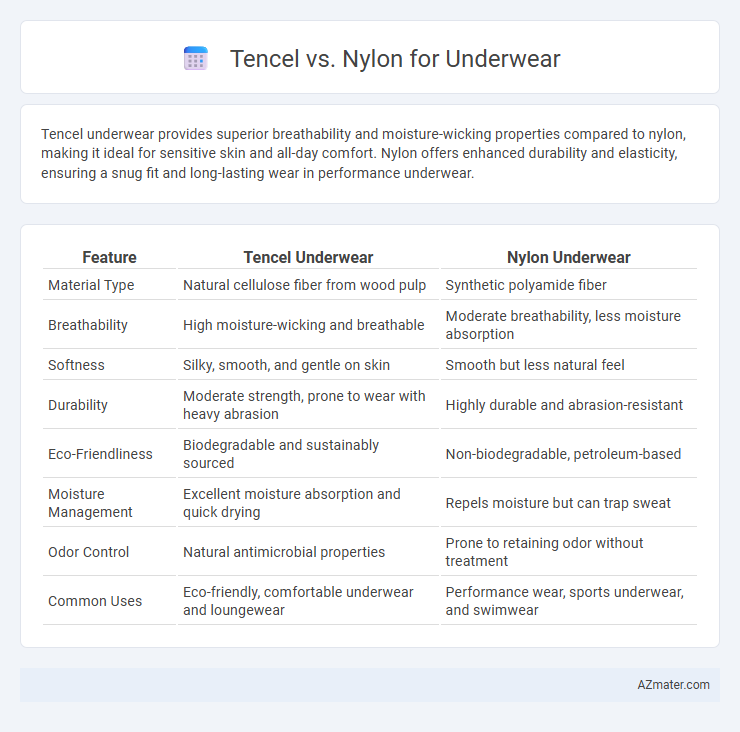Tencel underwear provides superior breathability and moisture-wicking properties compared to nylon, making it ideal for sensitive skin and all-day comfort. Nylon offers enhanced durability and elasticity, ensuring a snug fit and long-lasting wear in performance underwear.
Table of Comparison
| Feature | Tencel Underwear | Nylon Underwear |
|---|---|---|
| Material Type | Natural cellulose fiber from wood pulp | Synthetic polyamide fiber |
| Breathability | High moisture-wicking and breathable | Moderate breathability, less moisture absorption |
| Softness | Silky, smooth, and gentle on skin | Smooth but less natural feel |
| Durability | Moderate strength, prone to wear with heavy abrasion | Highly durable and abrasion-resistant |
| Eco-Friendliness | Biodegradable and sustainably sourced | Non-biodegradable, petroleum-based |
| Moisture Management | Excellent moisture absorption and quick drying | Repels moisture but can trap sweat |
| Odor Control | Natural antimicrobial properties | Prone to retaining odor without treatment |
| Common Uses | Eco-friendly, comfortable underwear and loungewear | Performance wear, sports underwear, and swimwear |
Introduction to Tencel and Nylon Fabrics
Tencel, a sustainable fiber made from eucalyptus wood pulp, is renowned for its breathability, moisture-wicking properties, and silky softness, making it ideal for underwear that prioritizes comfort and eco-friendliness. Nylon, a synthetic polymer derived from petrochemicals, offers exceptional durability, elasticity, and quick-drying capabilities, often used in performance-focused underwear for enhanced stretch and resilience. Understanding the distinct fabric structures and environmental impacts of Tencel and Nylon helps consumers choose underwear that balances comfort, durability, and sustainability.
Key Differences Between Tencel and Nylon
Tencel is a sustainably produced, biodegradable fabric known for its exceptional breathability and moisture-wicking properties, making it ideal for sensitive skin and all-day comfort in underwear. Nylon, derived from petrochemicals, offers superior durability, elasticity, and resistance to abrasion but lacks the natural breathability of Tencel, often trapping heat and moisture. Choosing between Tencel and Nylon centers on preferences for eco-friendliness and softness versus durability and stretch in underwear performance.
Breathability and Moisture Management
Tencel fibers offer superior breathability compared to nylon, allowing air to circulate more freely and reducing heat buildup. Tencel's natural moisture-wicking properties draw sweat away from the skin, promoting faster evaporation and keeping the wearer dry and comfortable. Nylon tends to retain moisture longer, making Tencel a preferred choice for underwear focused on effective moisture management and enhanced comfort.
Comfort and Softness Comparison
Tencel underwear offers superior softness and breathability due to its natural cellulose fibers, making it highly comfortable for sensitive skin and moisture-wicking during active wear. Nylon, while durable and smooth, tends to retain heat and can cause irritation or discomfort with prolonged use. Overall, Tencel provides a more breathable and gentle fabric experience, ideal for comfort-focused underwear.
Durability and Longevity
Tencel underwear offers excellent durability due to its strong cellulose fibers derived from eucalyptus wood, which resist wear and tear while remaining breathable and moisture-wicking. Nylon, made from synthetic polymers, is highly durable and abrasion-resistant, providing long-lasting underwear that withstands frequent washing and stretching without losing shape. Both materials ensure longevity, but nylon typically outperforms Tencel in terms of tensile strength and resistance to pilling.
Sustainability and Environmental Impact
Tencel underwear offers superior sustainability due to its eco-friendly production process, utilizing renewable wood pulp and a closed-loop system that recycles water and solvents, significantly reducing environmental pollution. Nylon production relies on petrochemicals, contributing to higher carbon emissions and non-biodegradable waste, posing long-term environmental hazards. Choosing Tencel supports reduced water consumption, biodegradability, and lower ecological footprints compared to the energy-intensive and pollution-heavy nylon manufacturing process.
Skin Sensitivity and Hypoallergenic Properties
Tencel fabric, derived from sustainably sourced eucalyptus trees, offers exceptional breathability and moisture-wicking properties that minimize irritation for sensitive skin, making it highly suitable for hypoallergenic underwear. Nylon, while durable and elastic, tends to trap heat and moisture, potentially causing discomfort or allergic reactions in individuals with skin sensitivities. Choosing Tencel underwear enhances comfort by reducing bacterial growth and allergens, whereas nylon may exacerbate sensitivity issues due to less efficient moisture management.
Care and Maintenance Tips
Tencel underwear requires gentle washing with cold water and mild detergent to maintain its softness and moisture-wicking properties, avoiding bleach and fabric softeners for longevity. Nylon underwear benefits from low-heat washing and air drying to prevent fiber damage and retain elasticity, with machine wash on a gentle cycle recommended. Both fabrics should be stored in a dry, cool place away from direct sunlight to prevent deterioration and maintain comfort.
Cost and Value for Money
Tencel underwear typically costs more upfront due to its sustainable production methods and natural fibers, but it offers superior breathability, moisture-wicking, and skin comfort, providing excellent value for money in long-term wear. Nylon underwear is generally cheaper and more durable, making it a budget-friendly option, though it may lack the same level of softness and eco-friendliness as Tencel. Evaluating cost versus performance, Tencel appeals to consumers prioritizing comfort and sustainability, while Nylon suits those seeking affordability and resilience.
Final Verdict: Which is Better for Underwear?
Tencel offers superior breathability, moisture-wicking, and softness, making it ideal for comfortable, eco-friendly underwear. Nylon provides greater durability and elasticity, ensuring long-lasting wear and support but may compromise breathability. For everyday underwear prioritizing comfort and sustainability, Tencel is the better choice, while nylon suits performance-focused or athletic use.

Infographic: Tencel vs Nylon for Underwear
 azmater.com
azmater.com